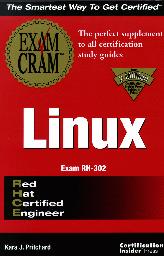

The Red Hat Certified Engineer program (RHCE) exam has a new book to go with it, Kara J. Pritchard's RHCE Exam Cram.

Author: Kara J. Pritchard
Publisher: Certification Insider Press/Coriolis
Price: $29.99 US
ISBN: 1-57610-487-7
Reviewer: Andrew G. Feinberg
Every time I walk into a bookstore, I see rows upon rows of Linux books and Windows books, all alike. However, the one area where Linux is lacking is in certification. Like myself, you may not believe that certifications are a true measure of ability. Nonetheless, Linux does have one certification exam in the form of the Red Hat Certified Engineer program (RHCE). This exam even has a new book to go with it, Kara J. Pritchard's RHCE Exam Cram.
The author assumes the reader knows a bit about UNIX in general and does not go into detail regarding basic skills. Chapter 1 is an introduction to the RHCE-300 exam itself, and Chapter 2 is an introduction to the history of Linux and free/open source software. The book includes a self-assessment at the beginning to determine whether one needs it. If you want a tutorial, this is not for you. For UNIX users who may not be administrators, Ms. Pritchard gives a good introduction to basic administration concepts in Chapter 3. Chapter 4 goes into great detail about the basics of TCP/IP and related services. Chapter 5 covers the basics of a Red Hat Linux installation, with which some readers might not be entirely comfortable, and after a brief interlude of basic system administration, Chapter 6 immerses the reader in dual-boots, kickstarts and other wonderful features of the Red Hat Linux installer. Chapter 8 covers quotas, run levels and the nitty-gritty of custom kernel compiles, as well as teaching one how to deal with crontab and profile files.
Chapter 9 does a wonderful job of showing how to configure the X Window System from scratch, as well as clueing a user in on several popular window managers including the GNOME and KDE environments. Chapter 10 describes how to configure Apache, Sendmail, FTP, DNS, NFS and Samba, as well as DHCP, Time Configuration and Squid. I found this section to be the most informative and useful outside of the realm of Red Hat Linux. I consulted the Samba section of the chapter when I had to help a friend configure a home network with Samba, which I had never done before.
Chapter 11 shows how to take a newly networked system and secure it, something every Linux administrator should know, including the basics of NIS, working with PAM, tcp_wrappers, routing and firewalls with ipchains.
Chapters 12 and 13 explain the process of the installation exam and the debugging exam, with Chapter 14 being a practice test and Chapter 15 its answer key. I am happy to report that I scored a 47 out of 50 on my first try, thanks to Ms. Pritchard's wonderful tutorials and test hints.
This being an exam preparation book, Ms. Pritchard does a good job of placing sample questions pertinent to each section throughout the book at the end of each chapter. She also lists external resources, such as HOWTOs, FAQs and other books on the subject at the end of each chapter. Every chapter has numerous exam hints, tips and tricks that are useful when you take your test.
Linux certification might not be the best way to ensure quality and skill of administrators, but it is a step toward getting Linux accepted in the corporate marketplace. Certification programs may produce cookie-cutter administrators, yet they will have very marketable and consistent skills useful not only with Linux, but with UNIX in general. Ms. Pritchard's book does a great job of introducing someone to, and preparing them for, the Red Hat Certified Engineer exam, and hopefully, will lead Linux users to bigger and more interesting learning experiences.